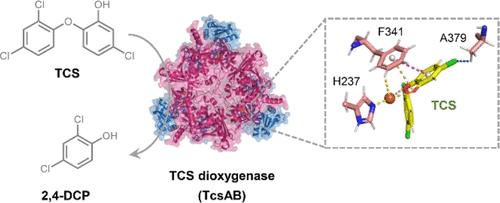当前位置:
X-MOL 学术
›
Environ. Sci. Technol.
›
论文详情
Our official English website, www.x-mol.net, welcomes your
feedback! (Note: you will need to create a separate account there.)
Triclosan Dioxygenase: A Novel Two-component Rieske Nonheme Iron Ring-hydroxylating Dioxygenase Initiates Triclosan Degradation
Environmental Science & Technology ( IF 10.8 ) Pub Date : 2024-07-16 , DOI: 10.1021/acs.est.4c02845 Yiran Yin 1, 2 , Hao Ren 1, 2 , Hao Wu 1, 2 , Zhenmei Lu 1, 2
Environmental Science & Technology ( IF 10.8 ) Pub Date : 2024-07-16 , DOI: 10.1021/acs.est.4c02845 Yiran Yin 1, 2 , Hao Ren 1, 2 , Hao Wu 1, 2 , Zhenmei Lu 1, 2
Affiliation

|
The emerging contaminant triclosan (TCS) is widely distributed both in surface water and in wastewater and poses a threat to aquatic organisms and human health due to its resistance to degradation. The dioxygenase enzyme TcsAB has been speculated to perform the initial degradation of TCS, but its precise catalytic mechanism remains unclear. In this study, the function of TcsAB was elucidated using multiple biochemical and molecular biology methods. Escherichia coli BL21(DE3) heterologously expressing tcsAB from Sphingomonas sp. RD1 converted TCS to 2,4-dichlorophenol. TcsAB belongs to the group IA family of two-component Rieske nonheme iron ring-hydroxylating dioxygenases. The highest amino acid identity of TcsA and the large subunits of other dioxygenases in the same family was only 35.50%, indicating that TcsAB is a novel dioxygenase. Mutagenesis of residues near the substrate binding pocket decreased the TCS-degrading activity and narrowed the substrate spectrum, except for the TcsAF343A mutant. A meta-analysis of 1492 samples from wastewater treatment systems worldwide revealed that tcsA genes are widely distributed. This study is the first to report that the TCS-specific dioxygenase TcsAB is responsible for the initial degradation of TCS. Studying the microbial degradation mechanism of TCS is crucial for removing this pollutant from the environment.
中文翻译:

三氯生双加氧酶:新型双组分 Rieske 非血红素铁环羟基化双加氧酶引发三氯生降解
新兴污染物三氯生(TCS)广泛分布在地表水和废水中,由于其难以降解,对水生生物和人类健康构成威胁。据推测,双加氧酶 TcsAB 负责 TCS 的初始降解,但其精确的催化机制仍不清楚。在本研究中,使用多种生化和分子生物学方法阐明了 TcsAB 的功能。大肠杆菌BL21(DE3) 异源表达鞘氨醇单胞菌 tcsAB 。 RD1 将 TCS 转化为 2,4-二氯苯酚。 TcsAB 属于双组分 Rieske 非血红素铁环羟基化双加氧酶 IA 族家族。 TcsA与同一家族中其他双加氧酶大亚基的氨基酸一致性最高仅为35.50%,表明TcsAB是一种新型双加氧酶。除 TcsA F343A突变体外,底物结合袋附近的残基诱变降低了 TCS 降解活性并缩小了底物谱。对全球废水处理系统 1492 个样本的荟萃分析表明, tcsA基因分布广泛。这项研究首次报道了 TCS 特异性双加氧酶 TcsAB 负责 TCS 的初始降解。研究TCS的微生物降解机制对于从环境中去除这种污染物至关重要。
更新日期:2024-07-16
中文翻译:

三氯生双加氧酶:新型双组分 Rieske 非血红素铁环羟基化双加氧酶引发三氯生降解
新兴污染物三氯生(TCS)广泛分布在地表水和废水中,由于其难以降解,对水生生物和人类健康构成威胁。据推测,双加氧酶 TcsAB 负责 TCS 的初始降解,但其精确的催化机制仍不清楚。在本研究中,使用多种生化和分子生物学方法阐明了 TcsAB 的功能。大肠杆菌BL21(DE3) 异源表达鞘氨醇单胞菌 tcsAB 。 RD1 将 TCS 转化为 2,4-二氯苯酚。 TcsAB 属于双组分 Rieske 非血红素铁环羟基化双加氧酶 IA 族家族。 TcsA与同一家族中其他双加氧酶大亚基的氨基酸一致性最高仅为35.50%,表明TcsAB是一种新型双加氧酶。除 TcsA F343A突变体外,底物结合袋附近的残基诱变降低了 TCS 降解活性并缩小了底物谱。对全球废水处理系统 1492 个样本的荟萃分析表明, tcsA基因分布广泛。这项研究首次报道了 TCS 特异性双加氧酶 TcsAB 负责 TCS 的初始降解。研究TCS的微生物降解机制对于从环境中去除这种污染物至关重要。











































 京公网安备 11010802027423号
京公网安备 11010802027423号